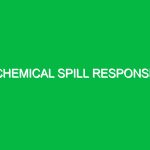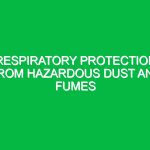The safe storage of chemicals is a critical aspect of health, safety, and environmental management. Whether in laboratories, manufacturing facilities, or warehouses, the proper handling and storage of chemicals are paramount to ensure not only compliance with regulations but also the safety of workers and the surrounding community. This article delves into the nuances of safe chemical storage, exploring potential hazards, safety precautions, and relevant regulations that govern this essential practice.
Understanding Safe Storage of Chemicals
Safe storage of chemicals refers to the systematic and controlled approach to storing hazardous substances to minimize risks associated with their handling and usage. This encompasses a range of practices aimed at preventing spills, leaks, and accidents that could result in serious injuries or environmental contamination. The relevance of safe chemical storage in the HSE domain cannot be overstated; it is integral to preventing workplace accidents, ensuring regulatory compliance, and safeguarding public health.
The Importance of Safe Chemical Storage
Consider a scenario in a chemical manufacturing plant where improper storage of flammable substances led to a devastating explosion. Such incidents not only cause fatalities but also lead to significant economic losses and environmental damage. By adopting safe storage measures, organizations can mitigate these risks and enhance the overall safety culture within their operations. Furthermore, compliance with safety regulations not only protects employees but also fosters public trust and corporate responsibility.
Identifying Hazards and Risks in Chemical Storage
When it comes to the safe storage of chemicals, recognizing potential hazards is the first step toward implementing effective safety measures. The risks associated with chemical storage can be categorized into several key areas:
1. Chemical Reactivity
Certain chemicals may react violently with others, leading to fires, explosions, or the release of toxic gases. For instance, mixing an oxidizer with a flammable substance can create a hazardous situation. Understanding the chemical properties and compatibility of substances is essential in preventing such incidents.
2. Toxicity and Health Risks
Many chemicals pose health risks through inhalation, skin contact, or ingestion. Chemicals like benzene or formaldehyde can have serious health implications, including respiratory issues and long-term health effects. Proper labeling and storage in designated areas can help mitigate these risks.
3. Environmental Hazards
Spills or leaks can lead to environmental contamination, affecting soil, water, and air quality. The consequences of such incidents can be catastrophic, impacting not only the immediate area but also broader ecosystems. Organizations must plan for containment and remediation in their storage practices.
4. Physical Hazards
Improper storage can lead to physical hazards, including slips, trips, and falls. Containers that are not stored securely can topple over, causing spills. Moreover, inadequate signage or labeling can lead to confusion and mishandling of chemicals.
Best Practices for Safe Storage of Chemicals
To effectively mitigate the risks associated with chemical storage, organizations should adopt a series of best practices. These practices not only enhance safety but also promote a culture of responsibility among employees.
1. Conduct a Risk Assessment
Before storing any chemicals, it is crucial to conduct a thorough risk assessment. Identify the types of chemicals being stored, their properties, and the potential risks associated with them. This assessment should inform the storage strategy and safety protocols.
2. Use Proper Containers
Always use containers that are appropriate for the type of chemical being stored. For example, corrosive substances should be kept in containers made of materials that resist corrosion, such as polyethylene or glass. Ensure that all containers are clearly labeled with the contents and hazard symbols to prevent confusion.
3. Implement Segregation
To prevent dangerous reactions, store incompatible chemicals separately. Use color-coded storage systems or clearly marked shelves to designate areas for different categories of chemicals (e.g., flammable, corrosive, toxic). This simple step can save lives and prevent accidents.
4. Maintain Appropriate Temperature and Ventilation
Temperature control is essential for many chemicals. Store temperature-sensitive substances in climate-controlled environments, and ensure that storage areas are well-ventilated to disperse any potentially harmful vapors. Installing alarms to monitor temperature fluctuations can add an extra layer of safety.
5. Regular Inspections and Maintenance
Regularly inspect storage areas for signs of leakage, corrosion, or damage to containers. Implement a maintenance schedule to ensure that all storage facilities remain in good condition. Keeping the storage area clean and organized can also prevent accidents caused by clutter.
6. Training and Awareness
Ultimately, the safety of chemical storage hinges on the awareness and training of personnel. Conduct regular training sessions to educate employees on the hazards of the chemicals they handle, safe storage practices, and emergency response procedures. Encourage a culture of safety where employees feel empowered to report unsafe conditions.
Regulations Governing Safe Storage of Chemicals
Compliance with regulations is non-negotiable when it comes to the safe storage of chemicals. Various international and national standards guide organizations in best practices for chemical safety. Some key regulations include:
1. OSHA (Occupational Safety and Health Administration)
In the United States, OSHA sets forth regulations that require employers to ensure a safe workplace. This includes proper labeling of hazardous chemicals, the implementation of safety data sheets (SDS), and training for employees handling these substances.
2. EPA (Environmental Protection Agency)
The EPA regulates the storage of hazardous waste and chemicals to protect the environment. Organizations must comply with regulations regarding spill prevention, reporting, and remediation of hazardous materials.
3. NFPA (National Fire Protection Association)
The NFPA provides guidelines for fire safety related to chemical storage. Their codes outline the proper methods for storing flammable and combustible materials, ensuring that organizations minimize fire risks.
4. GHS (Globally Harmonized System of Classification and Labelling of Chemicals)
The GHS establishes internationally accepted criteria for classifying chemicals and communicating hazards. Compliance with GHS labeling standards helps ensure that all employees are aware of the risks associated with the chemicals they handle.
Conclusion
The safe storage of chemicals is a multifaceted challenge that requires a proactive approach. By understanding the potential hazards, implementing best practices, and adhering to relevant regulations, organizations can significantly reduce the risks associated with chemical storage. Safety should never be an afterthought; it must be ingrained in the culture of every workplace. As we continue to learn from past incidents and innovate in safety practices, we can create environments where chemicals are handled with the utmost care, protecting both people and the planet.


